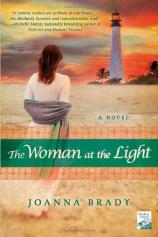The Woman at the Light
Review
The Woman at the Light
Key West food writer Joanna Brady pens a historical love story centering on the maritime antiquity of Key West and the Florida coastal wrecking industry. THE WOMAN AT THE LIGHT chronicles the life story of an early 19th-century feminine explorer who takes over her husband’s post as lighthouse keeper on the solitary island of Wrecker’s Cay, surrounded by an underwater coral forest. Emily Dinsmore tends the light while keeping an eye out for her missing husband. As an old woman, she recalls the glories of life and youth, the challenges and triumphs of love, years of passion and hardship, and the potent, enduring feelings she’s had for a slave who once lived and worked illegally at Wrecker’s Cay.
"Despite the rather ordinary, modern appearance of the book’s cover, THE WOMAN AT THE LIGHT is a true historical novel with many creative nuances and exceptional era details. This is the well-written creation of an experienced writer and a fantastic love story to boot."
Following a brief prologue of remembrances, THE WOMAN AT THE LIGHT dives into Emily’s youth and years as a coastal worker and committed lighthouse wife. Emily marries at age 18 in the year 1829, a naïve socialite attending a formal reception among French Quarter elites. She is introduced to a ship crewmate, a Bahamian carpenter and fisherman named Martin Lowry who presents himself as rugged and educated. Hastily discarding several well-meant warnings, Emily takes a chance and immediately consents to marry Martin after virtually no courtship. They leave New Orleans in full knowledge they’ll be facing difficult struggles supporting themselves, and Emily is enticed by --- and a little wary of --- the idea of pursuing their dreams together in Martin’s hometown of Key West.
Emily finds she’s had naïve ideas. After choosing a life and husband, she begins thinking of Key West as “her island prison.” Their newlywed years consist of Martin working long hours and Emily cooped up in a crowded boarding house among offensive sailors. Martin is consumed by worries over money and improving his lot, and in short time, Emily’s sweet views are replaced by “wifely duties” and respect for Martin’s status as supporter, but without passion. It is Martin’s dreams they follow, and Emily finds herself lowered, having to ask her rich family for money so she can satisfy her husband’s desires.
Due to Emily’s sizeable family resources, Martin is able to purchase a large parcel of land upon which he builds a lovely coastal home and working pineapple plantation. During these years, Emily bears him several children and sees their future looking up. For a short while, stability takes the place of worries, but piracy and greater issues in Key West and the shipping industries take precedence over needs of coastal families. The United States Navy, stationed in Key West, suddenly issues an unexpected claim over Martin’s land, offering no compensation for value or improvements. The two are forced to relinquish Martin’s dreams, moving to start over again, this time with children in tow. Bitter and desperate, Martin accepts the only post he can, that of lighthouse keeper on the island of Wrecker’s Cay, for meager compensation and a desolate outlook.
A few short years later, Martin disappears on the reef during a fishing trip while Emily “tends the light.” They’ve again built many structures and improvements to their ground, and Emily works diligently daily to become a major source of knowledge and support as a lighthouse wife --- a necessity since Martin is away frequently, supplementing their income as a “wrecker” (a salvager of lucrative cargoes of wrecked vessels, a practice Emily compares to piracy).
At the time of Martin’s disappearance, Emily is only beginning to settle down emotionally and regrets losing her husband and his company. She assumes he’s met some gruesome end and determines to take his place as the lonely island’s sole lighthouse keeper, with the help of her three children. However, Emily is still unsure of exactly how she’ll manage as she’s newly pregnant. The arrival of an unexpected visitor --- a slave from The States who claims he’s been freed but captured illegally aboard a ship headed for the Caribbean --- changes everything.
Despite the rather ordinary, modern appearance of the book’s cover, THE WOMAN AT THE LIGHT is a true historical novel with many creative nuances and exceptional era details. This is the well-written creation of an experienced writer and a fantastic love story to boot. There are many artful expressions of a bygone era here with clear cultural differentiations and disgraces. It is the type of book that will inform readers about maritime life and the history of Key West, set in an age where practices of commercial sailing, human trafficking and slavery, and social elitism were all well and thriving. The advent of exciting new ideas like abolition of slavery and modern feminism were just beginning to take root. This all makes for a very interesting and thoughtful historical read.
Reviewed by Melanie Smith on July 5, 2012
The Woman at the Light
- Publication Date: July 3, 2012
- Genres: Fiction, Historical Fiction, Historical Romance, Romance
- Paperback: 352 pages
- Publisher: St. Martin's Griffin
- ISBN-10: 1250003563
- ISBN-13: 9781250003560










